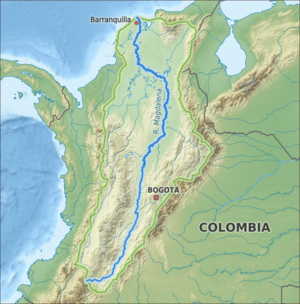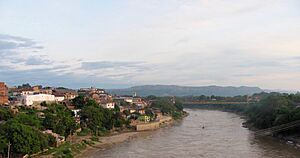Trachelyopterus insignis facts for kids
Quick facts for kids Trachelyopterus insignis |
|
|---|---|
| Conservation status | |
| Scientific classification | |
 |
|
| T. insignis is only found in the Rio Magdalena watershed (outlined). | |
| Synonyms | |
|
The Trachelyopterus insignis is a type of catfish that lives in freshwater. It belongs to a group of fish called the driftwood catfish family, known as Auchenipteridae. You can often find this fish in rivers in the northern parts of South America. People there have different names for it, like chivo (which means "goat"), rengue, or doncella (meaning "maiden").
Contents
About the T. insignis Name
This fish was officially described in 1878 by an Austrian zoologist named Franz Steindachner. He found it in the Rio Magdalena in Colombia. When he first described it, Steindachner put T. insignis into a different group of driftwood catfishes called Auchenipterus. Later, it was also moved into another group called Parauchenipterus, but that group is no longer used today.
What Does T. insignis Look Like?
These catfish show differences between males and females, which is called sexual dimorphism. When they are young, the main difference is their color: males have a spotted pattern, while females are plain. Once they grow up and are ready to have babies, the males develop a large spine on their back. Adult males can grow up to 20 centimeters (about 8 inches) long.
Where T. insignis Lives

The T. insignis catfish lives only in freshwater. It is found only in the lower Rio Magdalena river basin in Colombia. This fish prefers to live near the bottom of the water. It likes water with a pH level between 6.0 and 7.2 and temperatures between 23 and 38 degrees Celsius (73 to 100 degrees Fahrenheit). These temperatures are common in tropical areas. You can find T. insignis in rivers of all sizes, as well as smaller creeks and flooded areas.
How T. insignis Behaves
Like many other driftwood catfishes, T. insignis is nocturnal. This means it is active at night. During the day, it hides in logs or other shelters. When night comes, it comes out to find food.
T. insignis and Humans
The IUCN (International Union for Conservation of Nature) says that T. insignis is not currently in danger of disappearing. No special actions have been taken to protect it, but other studies suggest it has a low to medium risk of extinction.
These fish are not usually sold as pets in aquariums. However, they have been successfully bred in captivity. When bred, they need a bottom made of gravel and floating plants like watersprite.
See also
- Trachelyopterus lucenai


